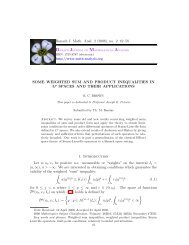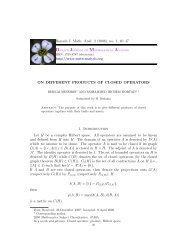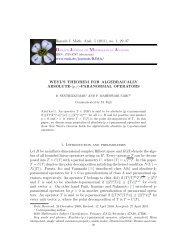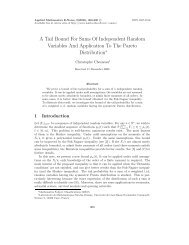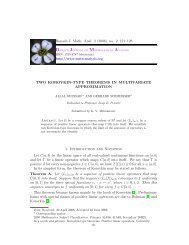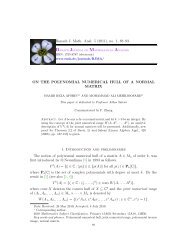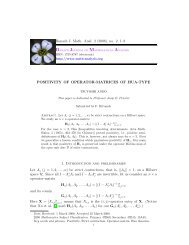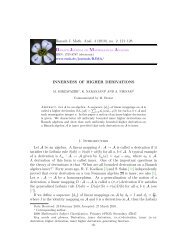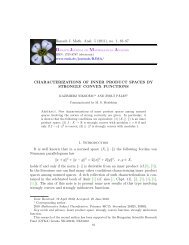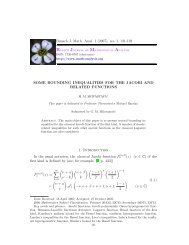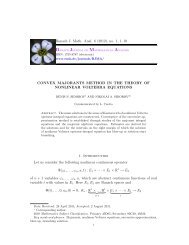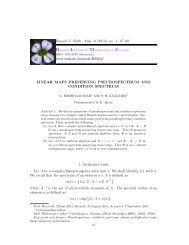Frames and Riesz bases for Banach spaces, and Banach spaces of ...
Frames and Riesz bases for Banach spaces, and Banach spaces of ...
Frames and Riesz bases for Banach spaces, and Banach spaces of ...
- No tags were found...
Create successful ePaper yourself
Turn your PDF publications into a flip-book with our unique Google optimized e-Paper software.
182 K. CHO, J.M. KIM, H.J. LEELet x ∈ X. Then x = ∑ n β nx n <strong>for</strong> some sequence (β n ) <strong>of</strong> scalars <strong>and</strong> <strong>for</strong> everyk F −1(x f n) k(x) = ∑ n β nF −1(x f n) k(x n ) = β k . Hence x = ∑ n F −1(x f n) n(x)x n . It isimmediate that (F −1(x f n) n) is equivalent to (f n ). □If B s is reflexive <strong>and</strong> (x n ) is a Y s -<strong>Riesz</strong> basis <strong>for</strong> X, then X is reflexive <strong>and</strong>so (x n ) is a B s -frame <strong>for</strong> X ∗ <strong>and</strong> F (xn)(X ∗ ) = B s by Theorem 3.2 <strong>and</strong> Corollary3.10. Then by the pro<strong>of</strong> <strong>of</strong> Theorem 3.12 we haveTheorem 3.13. Suppose that (e n ) is a Schauder basis <strong>for</strong> B s <strong>and</strong> (f n ) is aSchauder basis <strong>for</strong> Y s . Let B s be reflexive. If (x n ) is a Y s -<strong>Riesz</strong> basis <strong>for</strong> X,then there exists a B s -<strong>Riesz</strong> basis (x ∗ n) <strong>for</strong> X ∗ , which is a biorthogonal sequence<strong>for</strong> (x n ), so thatx = ∑ x ∗ n(x)x n , x ∗ = ∑ x ∗ (x n )x ∗ nnn<strong>for</strong> every x ∈ X <strong>and</strong> x ∗ ∈ X ∗ .If (x ∗ n) ∈ Bsw∗ (X ∗ ) (or B s is reflexive) <strong>and</strong> (x ∗ n) is a Y s -<strong>Riesz</strong> basis <strong>for</strong> X ∗ , then(x ∗ n) is a B s -frame <strong>for</strong> X <strong>and</strong> F (x ∗ n )(X) = B s by Theorem 3.4 <strong>and</strong> Corollary 3.11.Then by the pro<strong>of</strong> <strong>of</strong> Theorem 3.12 we have the following which extends [11,Theorem 2.8].Theorem 3.14. Suppose that (e n ) is a Schauder basis <strong>for</strong> B s <strong>and</strong> (f n ) is aSchauder basis <strong>for</strong> Y s . Let (x ∗ n) ∈ Bsw∗ (X ∗ ) (or B s be reflexive). If (x ∗ n) is aY s -<strong>Riesz</strong> basis <strong>for</strong> X ∗ , then there exists a B s -<strong>Riesz</strong> basis (x n ) <strong>for</strong> X, which is abiorthogonal sequence <strong>for</strong> (x ∗ n), so thatx = ∑ n<strong>for</strong> every x ∈ X <strong>and</strong> x ∗ ∈ X ∗ .x ∗ n(x)x n ,x ∗ = ∑ nx ∗ (x n )x ∗ n4. <strong>Banach</strong> frames <strong>and</strong> atomic decompositionsFor an operator S : B s → X, a sequence (x n ) in X <strong>and</strong> a B s -frame (x ∗ n) in X ∗<strong>for</strong> X, we say that ((x ∗ n), S) (resp. ((x ∗ n), (x n ))) is a <strong>Banach</strong> frame (BF) (resp.an atomic decomposition (AD)) <strong>for</strong> X with respect to B s if(S[(x ∗ n(x))] = x resp. ∑ )x ∗ n(x)x n = xn<strong>for</strong> every x ∈ X. The BF <strong>and</strong> AD <strong>for</strong> <strong>Banach</strong> <strong>spaces</strong> were introduced <strong>and</strong>studied by Gröchenig [15], <strong>and</strong> Casazza, Han, Larson, Christensen <strong>and</strong> Heil [8, 10],respectively. Recently, some abstract theories <strong>for</strong> them were studied by Car<strong>and</strong>o,Lassalle <strong>and</strong> Schmidberg [3, 4], <strong>and</strong> Casazza, Christensen, Stoeva [7]. The purpose<strong>of</strong> this section is to sharpen some recent results [3, 4, 7] <strong>for</strong> the BF <strong>and</strong> AD.First we consider the existence problem <strong>of</strong> the BF <strong>and</strong> AD <strong>for</strong> <strong>Banach</strong> <strong>spaces</strong>.In [8, Theorem 2.10], it was shown that there exists an AD <strong>for</strong> a <strong>Banach</strong> space Xif <strong>and</strong> only if X is separable <strong>and</strong> has the bounded approximation property (BAP).Thus there exist a separable reflexive <strong>Banach</strong> space Z, which does not have theBAP (see [12]), such that there is no AD <strong>for</strong> Z. Also we will see that there is noBF <strong>for</strong> every nonseparable reflexive <strong>Banach</strong> space from the following proposition.




